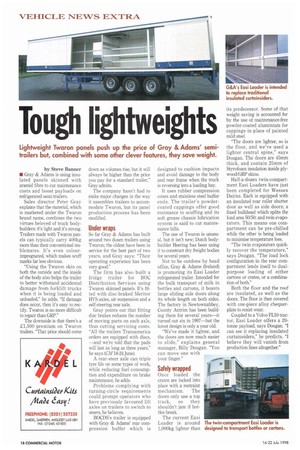Tough lightweights
Page 20

If you've noticed an error in this article please click here to report it so we can fix it.
Lightweight Twaron panels push up the price of Gray & Adams' semitrailers but, combined with some other clever features, they save weight.
by Steve Banner • Gray & Adams is using insulated panels skinned with aramid fibre to cut maintenance costs and boost payloads on refrigerated semi-trailers.
Sales director Peter Gray explains that the material, which is marketed under the Twaron brand name, combines the two virtues beloved of truck bodybuilders: it's light and it's strong. Trailers made with Twaron panels can typically carry 400kg more than their conventional stablemates. It's even colourimpregnated, which makes scuff marks far less obvious.
"Using the Twaron skin on both the outside and the inside of the body also helps the trailer to better withstand accidental damage from forklift trucks when it is being loaded and unloaded,'' he adds. "If damage does occur, then it's easy to rectify. Twaron is no more difficult to repair than GRP."
The downside is that there's a £1,500 premium on Twaron trailers. "That price should come down as volumes rise, but it will always be higher than the price you pay for a standard trailer," Gray admits.
The company hasn't had to make major changes in the way it assembles trailers to accommodate Twaron, but its panel production process has been modified.
Under wraps
So far Gray & Adams has built around two dozen trailers using Twaron; the oldest have been in service for the best part of two years, and Gray says: "Their operating experience has been very good."
The firm has also built a fridge trailer for BOC Distribution Services using Twaron skinned panels. It's fitted with disc-braked Mentor EIVS axles, air suspension and a self-steering rear axle.
Gray points out that fitting disc brakes reduces the number of moving parts on each axle, thus cutting servicing costs. "All the trailers Transamerica orders are equipped with discs, —and we're told that the pads will last as long as three years," he says (CM 18-24 June).
A rear-steer axle can triple tyre life on some types of work, while reducing fuel consumption and expenditure on brake maintenance, he adds.
Problems complying with turning-circle requirements could prompt operators who have previously favoured lift axles on trailers to switch to steers, he believes.
BOCDS's trailer is equipped with Gray & Adams' rear compression buffer which is designed to cushion impacts and avoid damage to the body and rear frame when the truck is reversing into a loading bay.
It uses rubber compression cones and stainless steel buffer ends. The trailer's powdercoated cappings offer good resistance to scuffing and its soft grease chassis lubrication system is said to cut maintenance bills.
The use of Twaron is unusual, but it isn't new; Dutch bodybuilder Heering has been using it to construct dry freight bodies for several years.
Not to be outdone by head office, Gray & Adams (Ireland) is promoting its Easi Loader refrigerated trailer. Intended for the bulk transport of milk in bottles and cartons, it boasts large sliding side doors along its whole length on both sides. The factory in Newtownabbey, County Antrim has been building them for several years—it turned out six in 1997 but the latest design is only a year old.
"We've made it lighter, and the doors are now much easier to slide," explains general manager, Billy Dougan. "You can move one with your finger."
Safely wrapped
Once loaded the crates are locked into place with a restraint mechanism. The doors only use a top track, so they shouldn't jam if bottles break.
The current Easi Loader is around 1,000kg lighter than its predecessor. Some of that weight saving is accounted for by the use of maintenance-free powder-coated aluminium for cappings in place of painted mild steel.
"The doors are lighter, so is the floor, and we've used a lighter central spine," says Dougan. The doors are 45mm thick, and contain 25mm of Styrofoam insulation inside plywood/GRP skins.
Half-a-dozen twin-compartment Easi Loaders have just been completed for Wessex Dairies. Each is equipped with an insulated rear roller shutter door as well as side doors; a fixed bulkhead which splits the load area 50/50; and twin evaporators. This means one compartment can be pre-chilled while the other is being loaded to minimise temperature loss.
"The twin evaporators quickly recover the temperature," says Dougan. "The load lock configuration in the rear compartment lends itself to dualpurpose loading of either cartons or crates, or a combination of both."
Both the floor and the roof are insulated, as well as the doors. The floor is then covered with one-piece alloy chequerplate to resist wear.
Coupled to a Volvo FL10 tractor, Easi Loader offers a 20tonne payload, says Dougan. "I can see it replacing insulated curtainsiders," he predicts. "I believe they will vanish from production lines altogether."
















































































































